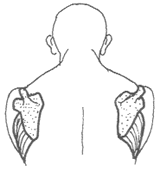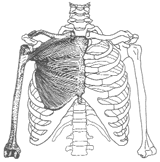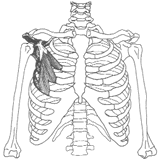Positive Health Online
Your Country

VDUs and the Computer Posture
listed in back pain, originally published in issue 31 - August 1998
Computer posture and time expenditure
These days large numbers of people spend hours at a workstation where all the information they need is concentrated and the space within which they operate is diminishing. We spend hours sitting at a desk staring at a visual display unit, making small movements with our forearms and fingers when using a keyboard or a mouse.
Health and safety guidelines are available to most individuals within organisations, yet even these are not well adhered to. A computer screen itself may appear harmless enough, but damage due to bad posture at a desk occurs insidiously.
Postural adaptations
Looking round an office it is easy to see examples of bad computer posture (see Diagram 1).
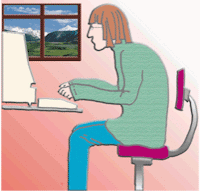
Diagram 1: Sucked into the World of the Computer Screen
As workers become sucked into the world of the computer screen the first postural adaptation to take place is for the shoulders to be held anteriorly.
In a person working at the keyboard his/her arms are orientated in front of the body for long periods of time. This in turn causes an increase in tone of the anterior musculature and surrounding fascia to maintain this position.
The resulting notable imbalance of the anterior and posterior muscle tone begins the postural changes that are the source of many common problems.
As the shoulders take on a more 'hunched' appearance the dorsal spine follows the anterior movement of the scapulae. As if pulled by 'guy ropes,' there is a gradual increase in the thoracic kyphosis. This enhances the round shouldered appearance (see Diagram 2 ).
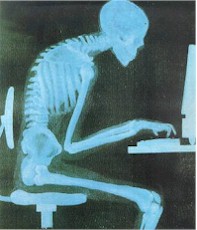
Diagram 2: Severe Spinal Damage at 0 mph
(Reprinted from National Back Pain Association poster.)
To counter-balance the anterior movement of the shoulders and thorax some degree of hyperextension has to occur in the cervical spine. This then enables proper of the head to see the screen. This extension is produced by the regional extrinsic muscles such as the Trapezius and Levator scapulae, which produces compression of the posterior structures, i.e. the Zygapophyseal facet joints (see Diagram 3).
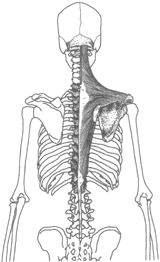
Diagram 3: Trapezius Muscle
The amount of cervical hyperextension is dependent on the degree to which the shoulders have dropped forward, and the individual's weight-bearing has shifted anteriorly.
Structural changes in the body
Changes in the structure of the body brought about by faulty and inefficient posture do not occur overnight. They are the result of an insidious process that originates from continuing misuse and, therefore, a decrease in the normal functioning of the body. This is a process that, once started, cannot be rectified by a simple change to the correct posture, partly because the incorrect posture may have become "the norm" for that individual, particularly if he/she suffers from tension or anxiety, which tend to maintain the damaging posture.
The immobility and stasis that occurs due to this adopted posture are the main culprit in many common functional disorders.
Resultant Common ailments
The type of problems that patients tend to present varies according to a) their normal morphology and b) the superimposed factors mentioned above. A list of these problems is shown in Table 1.
|
Table 1
Resultant Disorders
1. Tension headaches can be caused by the hyperextended upper cervical spine. Commonly these headaches occur by irritation of the sub-occipital muscles and neural structures. This produces pain in the cranial base, as well as the temporal and frontal/orbital regions. 2. Neck pain can also come from a variety of sources. As well as the aforementioned spondylarthrotic changes in the zygapophyseal facet joints, local pain can be of an ischaemic nature. The local muscles become starved of oxygen due to their chronic hypertonia and, therefore, restriction of the local circulation. The increase in cervical lordosis also enhances the risk of disc degeneration and possible associated nerve root irritation or entrapment. The resulting neuralgia can cause debilitating pain in the upper extremity. 3. Gleno-Humeral pain can occur from overstrain of ligamentous, muscular and fascial structures on the anterior aspect of the shoulder. These structures shorten over time following chronic hypertonia reinforcing the forward migration of the scapulae. The forward movement of the scapulae in turn shortens the same ligaments muscles and fascia. As the scapulae migrate forward their attachments approximate allowing this shortening to occur (see Diagram 4).
6. Thoracic pain can arise due to the postural changes and associated compromise of the dorsal architecture. Thoracic muscles and joints become relatively inflexible and more easily damaged as a result of poor posture. For example, prolonged and habitual anterior movement of the torso can result in ischaemic muscle pain in the para-spinal muscles of the dorsal spine, as these muscles work hard to maintain an erect posture. The ribs move less efficiently, with decreased excursion and elasticity, leaving the rib cage vulnerable to injury. 7. Respiratory problems can arise from the restriction in lung field expansion. The normally efficient gaseous exchange within the lungs is inhibited due to restriction of movement of the pleura and decrease in rib excursion caused by the increased dorsal kyphosis. The diaphragm also has less room for excursion so full expansion of all lung fields is inhibited. The alveoli are not fully inflated and stasis occurs at these terminal points. This may even create a ‘pseudo-asthmatic’ condition in which bronchodilators may be prescribed unnecessarily. 8. Digestive disturbances are not uncommon. Normal diaphragmatic movement aids healthy gut motility and provides a masticatory effect on the abdominal contents. Lack of movement of the diaphragm can result in a certain amount of stasis in the abdominal cavity and could be one of the major contributors to conditions such as irritable bowel syndrome. 9. Lower back pain rarely occurs as a primary symptom of bad computer postures. Normally the anterior shift in the centre of gravity initially causes symptoms elsewhere e.g. in the dorsal spine. This then leads to focal strain on the lower lumbar spine and discs. The shift in weight-bearing and resultant correction of this through increased muscle tone in the lower back affects the spine by reducing flexibility. This therefore leaves the spine weaker overall and more susceptible to local injury. |
Ways of counteracting these changes
Both computer manufacturers and the Health and Safety Executive have produced guidelines on the use of computers relating to duration of use and design of workstations. There are even companies who run programmes to advise workers on efficient and safe computer use. However, even when all these guidelines are adhered to, bad computer posture is still a risk. It is so easy to forget all the advice given when you are at work and your attention is focused on the computer screen.
Stretching exercises
Through working with many people who present with computer associated problems I have found that Osteopathic treatment is very effective in resolving these problems. However, once a patient returns to their VDU and resumes their work the environment remains conducive to the recurrence of these problems.
Stretching exercises to open out the chest and pectoral girdle region provide a simple way to prevent the return or onset of all the above conditions. Not only computer users, but anyone working in a confined space can benefit from these.
The aim of these exercises is to balance the patient and bring their centre of gravity back over the pelvis.
Standing with one arm outstretched to the side and both shoulders level, place the hand against a door frame. Without allowing any anterior rotation of the gleno-humeral joint slowly turn away from the door, gently stretching the pectoral muscles and anterior fascia of the chest. The exercise should be repeated bilaterally, holding the stretch for a few seconds each time and repeated regularly before, or when necessary, during work. This allows for the relocation of the scapulae and resultant increased mobility of the pectoral girdle and dependent surrounding structures (see Diagrams 6 & 7).
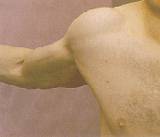
Diagram 6: Pectoral muscle stretch
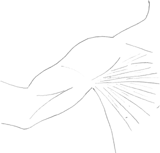
Diagram 7: Sub-cutaneous view of Pectoral muscle stretch
Summary
In summary it should be said that though a great deal of advice is available regarding the use of computers, the full relevance and wide-ranging effects of inappropriate use are seldom fully considered. The aetiology of many common ailments may be better understood through these structural changes, which frequently occur as a result of bad posture. This can be avoided if mobility in the shoulder girdle is maintained. The normal function of these problems areas (1-9) will also be retained in other posturally dependent regions throughout the body.
It is important to note that the effects that have been discussed are not exclusive to people using computers. However, it is with the rise of computer use that these may be becoming more commonplace. Ironically many health care professionals and body workers are also at risk as their work may also focus upper extremity use in front of the body and therefore increase anterior weight bearing.
Gentle repetitive stretching to loosen and balance the pectoral girdle may hold the key to easing many modern ailments. This type of stretching is easily done, greatly under valued, and may stem the progress of this modern day epidemic.
References
1. Travell and Simons (1983). Myofascial Pain and Dysfunction. Williams and Wilkins.
2. A.T. Still (1910). Osteopathy, Research and Practice.
3. Stanley Kelelman (1985). Emotional Anatomy. Centre Press.
4. (1967) The Physiological Basis of Osteopathic Medicine. Insight.
5. (1998) Working with VDUs. Printed and Published by the Health and Safety Executive.
Acknowledgements
* Adam Fagin. Photography
* Daniel Cohen. Model
* Hannah Rohan. Illustrator
* The National Back Pain Association for allowing reprint of Poster: 'Severe Spinal Damage at 0 mph'
Comments:
-
No Article Comments available
